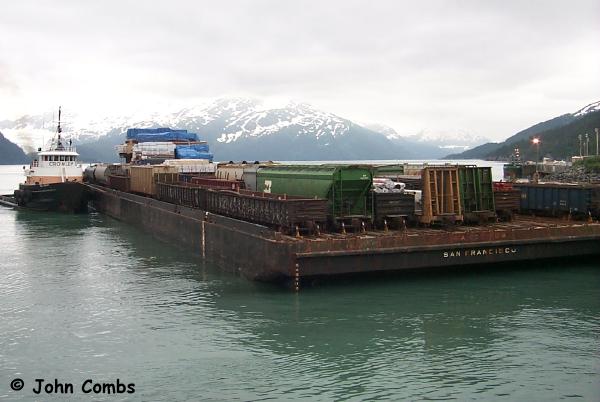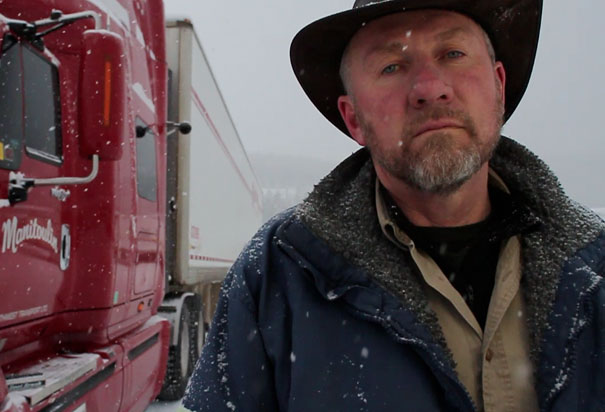The rail-barge-rail shipments from Washington to South-Central are pretty effective now. I don't see this making much change for Alaska, just oil for the pipeline.


Posted on 01/13/2013 3:33:52 PM PST by thackney
Two ventures aiming to break the logjam facing Western Canadian producers seeking new markets for their crude oil face crucial tests in January.
Vancouver-based Generating for Seven Generations, or G7G, is expecting to know whether it will get C$40 million in financing to study the feasibility of its plan to build a rail line from Alberta to Alaska to connect with the Valdez Marine Terminal, while a coalition of railroads and producers is scheduled to decide whether it will conduct an experimental shipment of 2 million barrels of crude this summer through the Hudson Bay port at Churchill, Manitoba, to either the North American Atlantic Seaboard or Europe.
G7G Director Matt Vickers said his company’s plan involves a 1,600-mile rail line from the Alberta oil sands to Delta Junction, Alaska, where it would feed into the Trans Alaska Pipeline System to Valdez.
The grand objective for the proponents is to eventually carry up to 5 million barrels per day on a twin-track system that would allow 12 trains per day to deliver crude to super tankers at Valdez, with each train of 240 cars carrying about 153,000 barrels.
Vickers said G7G has been in discussions over the past two years with governments in Alberta, British Columbia, the Yukon and Alaska to outline its proposal and has met with the Alberta Energy Department’s strategic initiatives team.
He said the overriding impetus behind the G7G plan is to “keep supertanker traffic off Canada’s pristine West Coast.”
Pressure for new markets
Alberta, faced with a possible budget deficit of C$3 billion in the current fiscal year, and the industry are under pressure to open up new markets beyond North America to receive Brent-based pricing for their product and overcome entrenched opposition from First Nations, environmentalists and landowners to the plans for new pipelines from Alberta to the U.S. Gulf Coast, eastern Canada and the U.S. and tanker ports at Kitimat, Prince Rupert and Vancouver on the British Columbia coast. Alberta Energy Minister Ken Hughes has ranked the effort to secure new markets as one of the most important challenges facing his province.
“The strategic imperative is that we get our products to the ocean so that we can obtain global prices,” he said.
“The solutions are additional pipelines to the West Coast, to the East Coast and to the Gulf Coast and also train-car delivery of bitumen and oil products to the coast.”
Century-old dream
The bid for the G7G rail link is a revival of a century-old dream and studies commissioned in 2005 and 2007 by the Alaska and Yukon governments to build a resource-based line tying Alaska with Canada and the Lower 48 to import and export a variety of goods. That work concluded the idea could succeed based on the movement of containers and trains carrying products such as iron ore, coal, base metals, grains and fertilizer, making remote resource exploration and development more feasible.
Vickers said the “whole reason for our (crude oil) project is to keep super tanker traffic off Canada’s pristine West Coast.”
He said studies have “demonstrated that a rail link to Alaska is a viable alternative to the oil pipelines currently being planned across British Columbia … and will avoid many of the environmental risks associated with current pipeline proposals.”
“Diversifying markets for Canadian oil is an important challenge, but we need to achieve this goal in the most environmentally and socially responsible way possible,” Vickers said.
C$10.4 billion estimate
He noted that the preliminary cost estimate of C$10.4 billion for a double-track Alberta-Alaska rail link (C$8.4 billion for a single track to handle 1.5 million bpd) compares more than favorably with the price tags of C$5.5 billion for Enbridge’s 525,000 bpd Northern Gateway project and the C$4.1 billion to add 450,000 bpd to Kinder Morgan’s existing 300,000 bpd Trans Mountain pipeline — both seeking to open new markets for oil sands bitumen in Asia. Vickers said that if the feasibility study provides the groundwork for filing a regulatory application, the proposal would likely involve a twin-track system, with the rail service provided by an existing or a new company.
G7G estimates that producers would pay C$6-C$8 per barrel to ship by rail, compared with the C$5 Northern Gateway proposes to charge.
Vickers also noted that Alaska tribes and Canadian First Nations affected by the rail plan have given their full support to the feasibility study, but emphasized he did not presume to translate that into aboriginal support for the project until a rail route has been selected.
He said that would come only if the feasibility study clears the way for G7G to proceed with “two years of full-blown community consultation.”
First Nations support concept
Following several months of negotiations, Simon Mervyn, chief of British Columbia’s Na-cho Nyak Dun, said in a statement First Nations “fully support the concept because, in reality, if we don’t take the initiative, somebody else will.” Vickers said there has been only limited contact so far with oil producers, including a brief meeting with officials at Suncor Energy, the largest oil sands producer.
He said Suncor indicated its position on the use of rail has changed over the last six to 12 months since the rapid expansion of rail shipments out of the Bakken region.
Simon Dyer, policy director at the Alberta-based Pembina Institute, told the Edmonton Journal that moving bitumen by rail comes with risks that will need to be evaluated.
“Transporting dangerous goods by rail has a higher frequency of incidents than pipeline, (thought) pipeline spills tend to be of a larger magnitude,” he said.
G7G has selected the global engineering firm Aecon Canada, which participated in the 2005 and 2007 studies and helped prepare a scoping document, after holding discussions with firms such as SNC-Lavalin, Siemens and Worley Parsons.
Churchill a possibility
Meanwhile, the prospect of using Manitoba’s grain terminal at Churchill for a trial oil shipment, offers a “competitive cost advantage to deliver oil to multiple destinations for a short period of time each year,” said Jeff McEachern, executive director of the Churchill Gateway Development Corp., which has probed the idea with industry leaders in Calgary over the past six months. “It is not a full solution, but it has an economic advantage. It’s being looked at seriously because producers want optionality in how they transport their product to refineries and ease congestion in pipelines or rail service,” McEachern said.
Churchill, which has been used to export Western Canadian grain since 1929, is also experiencing a longer ice-free season that could be extended with the use of icebreakers.
The idea has progressed to a feasibility study involving a range of companies, including Hudson Bay Railway and its partner Canadian National Railway, and oil producers in Alberta, Saskatchewan and Manitoba.
Wonder how Churchill is feasible...as it is only usable 3-4 months out of the year, and, would have to be expanded to handle petro shipments. Also, the town is small, and probably not enough workers...some will have to be brought in at cost
More reason for Keystone
Great thing for both countries.
“There is no rail service into the state, all freight comes by ship or rail. “
????
Correct statement.
AND their freight that arrives via ship from, say Japan, must arrive on a US flagged ship with US crew. This requires LOTS of extra handling and costs go way up.
The railroad would indeed be a GREAT thing for them.
More power to them, just as long as Tax Cheat Warren Buffoon and his toy railroad doesn’t somehow get to worm his way in and get to transport one drop of crude!
I can dig it!!! Let’s Roll!!!
I am a former cargo ship owner.....several break bulk and roro
Any flagged ship unless barred can deliver goods from a foreign port to US
And with any crew they want
They only need US flag to go between US ports unless waivered in emergencies like relief efforts
The rail-barge-rail shipments from Washington to South-Central are pretty effective now. I don't see this making much change for Alaska, just oil for the pipeline.


I used to live in Alaska. The majority of stuff comes up from Washington.
The Jones Act applies only in the case of US port to US port.
As long as the oil finds its way onto the global market we will all benefit from it.
"Ay? I don't like that idea."

True that is, but this proposal would take Canadian Oil to the L48 West Coast.
And thus it becomes part of the global market.
Which is why they're planning a double-track line.
Then explain why.....
In January '12 a waiver was granted to the Russian icebreaking tanker 'Renda" for emergency shipment of gasoline from N. Japan to Nome. Nome was iced in at the time and could not get normal intrastate barge shipments.
It needed the Jones Act waiver to carry from US port to US port.
But not from a foreign port to the US.
I think they tried but failed to do so after Sandy due to unions and Democrats protesting of foreign flagged non union crewed ships ferrying supplies to NJ and NY harbours from southern US relief sites.
think for a second, why would you ever think only US flagged vessels with US (Merchant Marine) crews can ply US ports...there are nowadays only 191 US flagged cargo vessels worldwide, in 1955 there were 1200. ...there are over 200 cargo ships and tankers in US Gulf ports right now as we speak is my guess...I'm sure there is some port traffic site I could find...there are not enough and they are way too costly to compete...in my shipping days I only saw US flagged ships as relief vessels, research and Jones Act vessels...never intercontinental anymore
have you seen merchant marine union scale....whew...it's 10 times Filipino I can promise you and of course replete with hours regs which will mean double crew and so forth...no thanks
here is a site synopsis of the Renda situation:
JONES ACT WAIVER ALLOWS RENDA TO DELIVER EMERGENCY FUEL SUPPLY TO NOME, ALASKA By Lysander Johnson posted in Recent Maritime News on Wednesday, January 18, 2012
Russian-flagged 371-foot tanker RENDA, escorted through over 300 miles of ice-covered seas by U.S. Coast Guard icebreaker HEALY, reached Nome, Alaska on Saturday, January 14, with 1.3 million gallons of unleaded gasoline and diesel fuel. Pumping the fuel into the town pipeline began safely during the few daylight hours on Monday. Normally, Nome residents would have received their full winter fuel supply by barge months ago, but a November storm made their final barge delivery impossible. Nome faced running out of fuel supplies before March or April if not for RENDA coming through with the first winter sea delivery ever to Nome. One solution was a very expensive fuel delivery by air, and that's exactly what might have been the only solution if it were not for a Jones Act waiver allowing the Russian vessel to operate in both Dutch Harbor to take on 400,000 of gasoline, and in Nome to deliver that gasoline as well as the diesel that RENDA had first loaded in South Korea.
Disclaimer: Opinions posted on Free Republic are those of the individual posters and do not necessarily represent the opinion of Free Republic or its management. All materials posted herein are protected by copyright law and the exemption for fair use of copyrighted works.